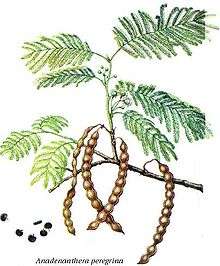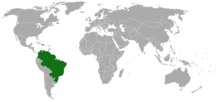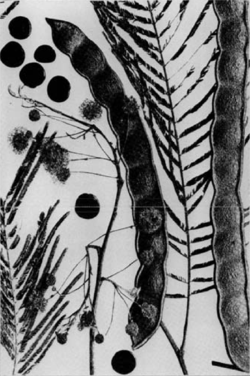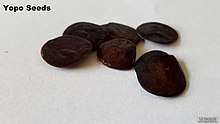Anadenanthera peregrina
Anadenanthera peregrina, also known as yopo, jopo, cohoba, parica or calcium tree, is a perennial tree of the genus Anadenanthera native to the Caribbean and South America.[1] It grows up to 20 m (66 ft) tall, and has a horny bark. Its flowers are pale yellow to white and spherical. It is an entheogen which has been used in healing ceremonies and rituals for thousands of years in South America.[2]
| Anadenanthera peregrina | |
|---|---|
 | |
| Scientific classification | |
| Kingdom: | Plantae |
| Clade: | Tracheophytes |
| Clade: | Angiosperms |
| Clade: | Eudicots |
| Clade: | Rosids |
| Order: | Fabales |
| Family: | Fabaceae |
| Clade: | Mimosoideae |
| Genus: | Anadenanthera |
| Species: | A. peregrina |
| Binomial name | |
| Anadenanthera peregrina (L.) Speg. | |
 | |
| Range of Anadenanthera peregrina | |
| Synonyms | |
|
Acacia angustiloba DC. | |
Related species
This plant is almost identical to that of a related tree, Anadenanthera colubrina,[3] commonly known as cebíl or vilca.[4] The beans of A. colubrina have a similar chemical makeup as Anadenanthera peregrina, with their primary constituent being bufotenin.[4]
Botanical varieties
Uses
Wood
The wood from A. peregrina is very hard and is used for making furniture.[5] It has a Janka rating of 3700 lb.[6] and a density of around 0.86 g/cm³.[7]
Toxicity
The beans (sometimes called seeds) and falling leaves are hallucinogenic and are toxic to cattle.
Chemical compounds
Chemical compounds contained in A. peregrina include:
- 2,9-dimethyltryptoline – plant[8]
- 2-methyltryptoline – plant[8]
- 5-MeO-DMT – bark,[8] bean
- 5-Methoxy-N-methyltryptamine – bark[8]
- Bufotenin – plant[8] beans[9]
- Bufotenin-oxide – fruit,[8] beans[9]
- Catechol – plant[8]
- Leucoanthocyanin – plant[8]
- Leucopelargonidol – plant[8]
- DMT – fruit,[8] beans, pods,[9] bark[10]
- DMT-oxide – fruit[8][11]
- N-Methyltryptamine – bark[8]
- Orientin – leaf[8]
- Saponarentin – leaf[8]
- Viterine – leaf[8]
The bark contains a high percentage of tannins, 587 mg CE/g extract.[12]
Entheogenic uses
Traditional usage


Archaeological evidence shows Anadenanthera beans have been used as hallucinogens for thousands of years. The oldest clear evidence of use comes from pipes made of puma bone (Felis concolor) found with Anadenanthera beans at Inca Cueva, a site in the northwest of Humahuaca in the Puna border of Jujuy Province, Argentina. The pipes were found to contain the hallucinogen DMT, one of the compounds found in Anadenanthera beans. Radiocarbon testing of the material gave a date of 2130 BC, suggesting that Anadenanthera use as a hallucinogen is over 4,000 years old.[13] Snuff trays and tubes similar to those commonly used for yopo were found in the central Peruvian coast dating back to 1200 BC, suggesting that insufflation of Anadenanthera beans is a more recent method of use.[14] Archaeological evidence of insufflation use within the period 500-1000 AD, in northern Chile, has been reported.[15]
Some indigenous peoples of the Orinoco basin in Colombia, Venezuela and possibly in the southern part of the Brazilian Amazon make use of yopo snuff for spiritual healing. Yopo snuff was also widely used in ceremonial contexts in the Caribbean area, including Puerto Rico and La Española, up to the Spanish Conquest.
Yopo snuff is usually blown into the user's nostrils by another person through bamboo tubes or sometimes snuffed by the user using bird bone tubes. Blowing is more effective as this method allows more powder to enter the nose and is said to be less irritating. In some areas the unprocessed ground beans are snuffed or smoked producing a much weaker effect with stronger physical symptoms. Some tribes use yopo along with Banisteriopsis caapi to increase and prolong the visionary effects, creating an experience similar to that of ayahuasca.
Effects
The first report of the effects of hallucinogenic snuff prepared from the beans of Anadenanthera peregrina dates back to 1496 when it was observed by Friar Ramon Pane, who was commissioned by Christopher Columbus, among the Taino Indians of Hispaniola. Pane's report was first published in 1511 in Martyr's descriptions of the New World. The description of its effects reads in part: "This kohobba powder," described as "an intoxicating herb, is so strong that those who take it lose consciousness; when the stupefying action begins to wane, the arms and legs become loose and the head droops." It is administered with a cane about one foot long of which they introduce one end "in the nose and the other in the powder and ...draw it into themselves through the nose". It worked quickly: "almost immediately they believe they see the room turn upside-down and men walking with their heads downwards". The administering witch-doctor took the drug along with his patients, intoxicating "them so that they do not know what they do and ... speak of many things incoherently", believing that they are in communication with spirits.[16]
Active constituents
Bufotenin
The beans have been found to contain up to 7.4% bufotenin.[17] At up to 7.4% (74 mg per gram) bufotenin, an effective 40 mg dose of insufflated bufotenin[17] requires little more than 0.5 grams of beans.
The intraperitoneal LD50 of bufotenin is between 200–300 mg/kg (in rodents) with death occurring by respiratory arrest. The LD50 in rodents scales to between 10,000 mg and 15,000 mg for a small 50 kg (110 lb) adult.[18] Based on the intraperitoneal LD50 for rodents, at 74 mg per gram, it would require approximately 135 grams of beans to reach the estimated LD50of bufotenin for a 50 kg (110 lb) adult. Human intravenous tests using bufotenin suggest the LD50 may be much lower in humans with subjects showing signs of peripheral toxicity (purple face, tachycardia, difficulty breathing, etc.) at doses as little as 8 mg in some subjects.[19] Free base bufotenin when insufflated, taken sublingually, orally, or intrarectally, elicits strong hallucinogenic effects with far less side effects.[17]
Dimethyltryptamine and 5-MeO-DMT
The beans have been found to contain up to only 0.04% 5-MeO-DMT and 0.16% DMT.[17] The leaves and bark also contain small amounts of DMT, 5-MeO-DMT and related compounds.[20][21][22]
At up to 0.04% (0.4 mg per gram) 5-MeO-DMT, an effective light 5 mg dose of insufflated 5-MeO-DMT would require over 12 grams of beans. It would be extremely difficult to insufflate such a quantity, as tolerance would likely develop before the 12-gram nasal intake could be completed. Individual sensitivity to 5-MeO-DMT varies. It has been documented that the threshold dose in some individuals is as much as 10 mg insufflated[23] requiring over 24 grams of beans for an effective dose of 5-MeO-DMT.
At up to 0.16% (1.6 mg per gram) DMT, an effective 40 mg dose of insufflated DMT would require 25 grams or more. Because of its volume, it’s likely to be impossible to insufflate the 25 grams of beans required to reach the active dose of DMT present in the beans. An extract of 25 grams of beans could contain up to 1,850 mg of bufotenin, a potentially dangerous dose. With insufflated freebase bufotenin, the maximum published safe dose used has been 100 mg.[17]
Unlike bufotenin, both DMT and 5-MeO-DMT are relatively unstable and begin to degrade rather quickly. Schultes and colleges (1977) examined a 120-year-old bean collection and found 0.6% bufotenin with no DMT or 5-MeO-DMT present at all. They also examined a batch of beans that contained all three compounds when fresh, but found only bufotenin in the beans after only two years of storage.[18]
Oral usage
When taken orally by some tribes in South America, small amounts are often combined with alcoholic chichas (maize beer).[18]:29 Moderate doses are unpleasant, producing nausea and vomiting. The beans were a main ingredient in bilca tauri, an oral purge medicine used to induce ritual vomiting once a month.[18] Large amounts are not usually consumed orally; as many tribes believe oral use is dangerous.
Use with MAOIs
Some South American tribes have been documented to use various bean preparations along with Banisteriopsis caapi, an herb containing monoamine oxidase inhibitors (MAOIs).[18] Typically Banisteriopsis caapi is chewed in the mouth while the Anadenanthera beans are snuffed or smoked.[18] Occasionally Banisteriopsis caapi is found mixed in with the snuff.[18]
See also
- Anadenanthera colubrina
- Cohoba
- List of plants of Caatinga vegetation of Brazil
- Nu-nu, a psychotropic snuff used by Matsés people
- Psychedelic plants
References
- "Anadenanthera peregrina - ILDIS LegumeWeb". www.ildis.org. Retrieved 2008-05-17.
- Carod-Artal, F. J.; Vázquez Cabrera, C. B. (July 2007). "[Ritual use of Anadenanthera seeds among South America natives]". Neurologia (Barcelona, Spain). 22 (6): 410–415. ISSN 0213-4853. PMID 17610173.
- Mota, Graciene S.; Sartori, Caroline J.; Miranda, Isabel; Quilhó, Teresa; Mori, Fábio Akira; Pereira, Helena (2017). "Bark anatomy, chemical composition and ethanol-water extract composition of Anadenanthera peregrina and Anadenanthera colubrina". PLOS ONE. 12 (12): e0189263. Bibcode:2017PLoSO..1289263M. doi:10.1371/journal.pone.0189263. ISSN 1932-6203. PMC 5744935. PMID 29281656.
- "Cebil (Anadenanthera colubrina) seeds". Azarius. Archived from the original on 2017-12-30. Retrieved 2017-12-30.
- PDF Caracterização da Madeira de Angico-Vermelho Archived December 13, 2007, at the Wayback Machine
- J.G. Architectural
- FAO
- Dr. Duke's Archived February 19, 2013, at the Wayback Machine Phytochemical and Ethnobotanical Databases
- "UNO". Archived from the original on 2005-01-20. Retrieved 2007-06-10.
- Medicina traditional Ergebnisse einethnomedizinischen ...(German) Archived February 5, 2012, at the Wayback Machine
- Peter Stafford , Jeremy Bigwood (1993). Psychedelics Encyclopedia. Ronin Publishing. pp. 420 pages. ISBN 0-914171-51-8.
- Mota, Graciene S.; Sartori, Caroline J.; Miranda, Isabel; Quilhó, Teresa; Mori, Fábio Akira; Pereira, Helena (2017-12-27). "Bark anatomy, chemical composition and ethanol-water extract composition of Anadenanthera peregrina and Anadenanthera colubrina". PLOS ONE. 12 (12): e0189263. Bibcode:2017PLoSO..1289263M. doi:10.1371/journal.pone.0189263. ISSN 1932-6203. PMC 5744935. PMID 29281656.
- Pochettino, M. L.; Cortella, A. R.; Ruiz, M. (1999). "Hallucinogenic Snuff from Northwestern Argentina: Microscopical Identification of Anadenanthera colubrina var. cebil (Fabaceae) in Powdered Archaeological Material". Economic Botany. 53 (2): 127–132. doi:10.1007/bf02866491. JSTOR 4256172.
- Cortella, M. Ruiz. 1995
- Juan P. Ogalde; Bernardo T. Arriaza; Elia C. Soto (2010). "Uso de plantas psicoactivas en el north de Chile: evidencia química del consumo de ayahuasca durante el periodo medio (500-1000 d.C.)". Latin American Antiquity. 21 (4): 441–450. doi:10.7183/1045-6635.21.4.441.
- EVANS-SCHULTES, Richard. "UNODC - Bulletin on Narcotics - 1969 Issue 4 - 003". www.unodc.org. Retrieved 2017-12-30.
- Pharmanopo-Psychonautics: Human Intranasal, Sublingual, Intrarectal, Pulmonary and Oral Pharmacology of Bufotenine by Jonathan Ott, The Journal of Psychoactive Drugs, September 2001
- Torres, Constantino Manuel; David B. Repke (2006). Anadenanthera: Visionary Plant of Ancient South America. New York, New York: Haworth Herbal Press. ISBN 0-7890-2642-2.
- TiKHAL, Alexander Shulgin, 1997
- Schultes 1976
- Schultes 1977
- Pachter et al. 1959
- Shamanic Snuffs or Entheogenic Errhines by Jonathan Ott, Page 102, 2001, ISBN 1-888755-02-4
| Wikimedia Commons has media related to Anadenanthera peregrina. |
| Wikispecies has information related to Anadenanthera peregrina |
Further reading
- Richard Evans Schultes (1992). Plants of the Gods. ISBN 0-89281-979-0.